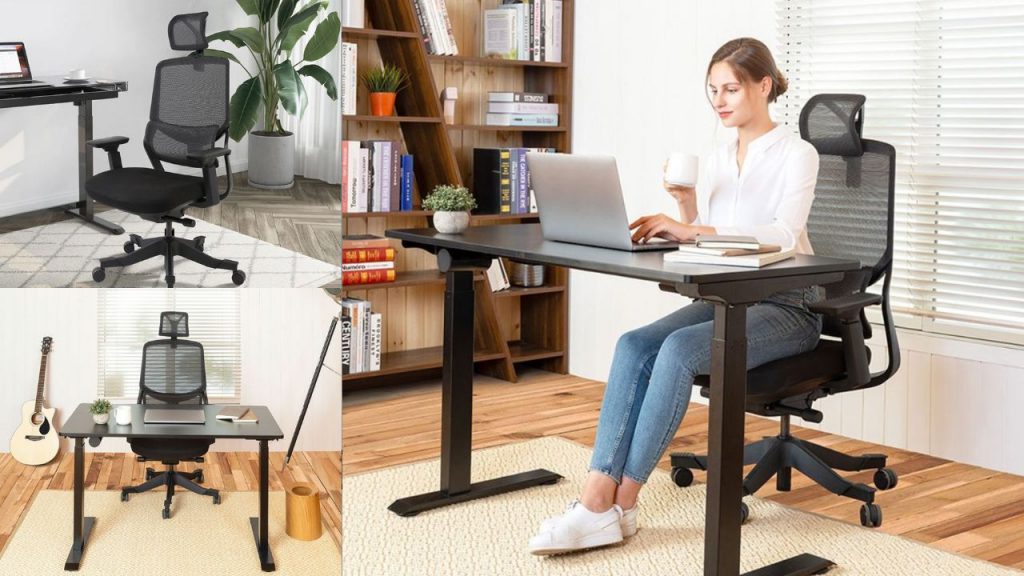How Office Chair Hydraulics Work? [Easy Explanation]
“Ergonomics” is the current buzzword in the market. If we have only one word to describe it, it would be “adjustability.” Ergonomic chairs allow you to roam around the desk with caster wheels, adjust the seat height, recline the backrest, and so on.
But today we will focus on one of these extraordinary features. We are talking about adjusting the seat height according to different users’ preferences. This feature requires a mechanism called hydraulics.
So, how does office chair hydraulics work?
The office chair hydraulic system comes with double-acting cylinders. The fluid (oil) moves between the cylinders and converts the piston’s pressure into enormous force. It leads to a lift in the chair seat.
But, that’s just the tip of an iceberg. We will elaborate on its mechanism in great detail in the following article. So, don’t go anywhere. Stay tuned.
Do Office Chairs Have Hydraulics?
The ability to adjust the seat height is a revolutionary element of an ideal office chair. We already know how important it is for the chair and desk to have a decent proportion. Otherwise, you would have to strain your shoulders while doing regular desk tasks.
The problem arises when several people use a chair during different shifts. Not everyone is going to have the same height. So, even if the chair manages to keep one employee in a straight position, it is impossible to do so for every user.
So, what’s the solution? And where does the struggle end?
Well, that’s the reason chair hydraulics were invented. And, office chairs have never been more comfortable. Now, almost every modern office consists of chairs with hydraulic lifting mechanisms.
The basic purpose of behind this installation is to lift or lower the seat according to your wish. You can pull the lever and make it lift to your desired point. So, the answer would be, yes. Chairs with hydraulic cylinders are the part and parcel of any modern 21st-century office interior.
So, how does this work?
How Office Chair Hydraulics Work?
Although it says “hydraulic” system, you won’t find a drop of water inside the chair base. It just refers to a fluid which is the life of this mechanism. Now you must be wondering, what kind of fluid goes in there?
Well, it’s mostly oil. To be more specific, mineral oil. Oil is also known as liquid metal. You can’t compress it like air. That characteristic makes it suitable to go into a hydraulic chair’s inner chamber.
The inner structure of a hydraulic office chair contains two cylinders. You can also call them “double-acting cylinders.” Both the cylinders are connected through valves that act as a medium of air relief for the system.
As you push the lever on the chair, a piston goes into the cylinder. Since the oil can’t be compressed, it moves through the joint pipe and enters the other cylinder. But, here is the catch. Pascal’s law teaches us that, force=pressure x area.
The second cylinder is designed to be wider than the previous one. As a result, when the piston pressurizes the fluid, it flows into another chamber carrying the same pressure. But, due to increased area, the force becomes more prominent.
In short, the chambers are designed to convert low pressure from the piston into a higher amount of force.
Another important thing is the cylinder’s expandability. Yes, the second cylinder comes with an expandable top cover. As a result, the extreme force leads to an increase in the compartment. That eventually makes the seat above it rise higher than before.
That’s the basic principle of how a hydraulic chair works. You can already guess what the mechanism will be when it goes down, right?
You press the lever and it triggers the piston to move outside the chamber. As it leaves the compartment, there is more room to fill up. Since the chamber is airtight, the gap must be filled with oil only. So, the oil starts moving back to the old compartment.
On the other hand, reduced oil level causes lower pressure. It subsequently compresses the cylinder’s volume by pulling the seat down. That seems pretty interesting, isn’t it?
My #1 Recommendation For Home Office Chair
If you want my only recommendation for an office chair that befits your home office, I’ll recommend the Flexispot OC10. Why? It features:
- 3D Lumbar Support, 4D Adjustable Armsets, 135° Lounge Tilt
- Made of Italian-imported chenille and K+R temperature-sensitive fiber
- Ultimate Breathable Mesh
- Best-In-Industry Samhongsa Class 4 Gas Lift
- Silent 360 degree casters
- 5 years warranty for frames, motors, and other mechanisms
- 2 year warranty for the electronic switches and controllers
And all this at a cost-effective price! To know more, check out my detailed article on this chair!
Are Office Chairs Hydraulic Or Pneumatic?
It is more common to find office chairs with a pneumatic lifting mechanism installed in them. However, it can be either hydraulic or Pneumatic. Both systems will provide pretty much the same result. The name sounds different but the mechanism is very similar.
Both involve a fluid to increase the pressure inside the cylinder. That leads to a smooth lift to the desired position.
However, the structure of cylinder chambers and the fluid type is absolutely different. You must get a clear understanding of their differences. So, you can pick an office chair with a “hydraulic” or “Pneumatic” lifting mechanism.
Here is a quick preview of the following discussion.
| Points of Comparison | Hydraulic System | Pneumatic System |
|---|---|---|
| Fluid Type | Oil (mineral) | Nitrogen gas |
| Uses | To lift and lower heavy equipment. For example: dental chairs, barber chairs. | To lift and lower lighter equipment. For example: regular office chairs. |
| Appearance | The rod is heavier and bulkier | The rod seems slender |
| safety | Safer (less chances of explosion) | Lower than hydraulic system |
| Cylinder Structure | Double-acting cylinder | Single-acting cylinder |
| Lubricant | No need (it already contains oil all the time) | Requires lubricant oil |
| Accuracy of the lift | Very accurate & precise | Low to medium accuracy |
As you can see, hydraulic chairs have more compartments. That’s the reason behind its bulkier and not-so-aesthetic look. You can easily spot hydraulic chairs at dentist offices and barbershops.
The logic is simple. your height needs to be at the perfect level for the dentist to perform important routine checks or surgery. Imagine the horror, if the chair raises above an optimum level. Hydraulic chairs make sure the users get the precise result without any falter.
But, there is another type of chair lifting mechanism. It is called a pneumatic system. Most office chairs follow the pneumatic principle during a lift. Below down we have explained the overall mechanism of this system.
Pneumatic System
As the name suggests, the air is used as the main fluid that moves into the cylinder. A Pneumatic office chair comes with a base, a caster wheelset, chair spine, a lever, and a comfy seat. Unlike the hydraulic ones, it comes with single-acting cylinders.
The cylinder is filled with nitrogen gas. Then, pascal’s principle is applied to use the gas’s movement and turn it into force. It leads to the chair being lifted.
Let’s get into more details. First of all, the single-cylinder has a limited amount of air inside it. There is a seal to lock the gas inside and maintain the pressure. Now, you want to sit on it. Press the lever and you can hear the “hissing” sound as the seat starts rising upwards.
Once you press the lever, it unlocks the piston from its current position. It starts moving into the cylinder. Because of it, the volume inside the chamber starts decreasing. Since the other side is locked, the air/gas can’t leave the confined place.
So, the only option is to compress the gas and make it adjust to the decreased compartment area. That’s exactly what happens inside a Pneumatic office chair’s base.
Now, the piston keeps moving inwards. Finally, the compressed air will push the seat to make the room into the cylinder. That’s how the lifting mechanism in a pneumatic system works.
The same thing happens when you want the chair to sink. You push the lever and it triggers the piston to move outside the chamber. As it keeps leaving the compartment, there is more room available for the air/gas.
The air will start expanding in volume and fill the entire space. That leads to a reduction in force towards the seat. As a result, the chair starts sinking. All of this happens inside the base and you can’t see any of it.

Do Hydraulic Chairs Explode?
You might have heard some horrific chair explosion stories from your colleague or friends. And, now you are reconsidering your decision. That’s understandable. The ultimate solution is to acquire enough knowledge regarding this issue. That way, you won’t have to fear your life every time while sitting down on the chair.
We can’t dismiss the probability of the hydraulic or pneumatic chairs exploding under you. But, the chances are too low. Also, it doesn’t happen randomly. Several factors lead to such tragic incidents.
Let’s look at some of them.
Regular Air
If you have a habit of cutting costs, we have bad news for you. The cheap hydraulic chairs come with regular air instead of nitrogen. The manufacturers fool you by pumping ordinary air into the cylinder. There is no way to identify it from the outside. It also lifts and lowers the chair just fine.
But the effect only lasts a while for such chairs. Slowly the oxygen starts to form a reaction with the cylinder. The result is a rusty inner chamber. Air can easily penetrate such chambers and lose its effectiveness.
The specialty of nitrogen is its consistency. It can maintain the range of pressure for a long period. Plus, nitrogen doesn’t let the cylinder oxidize.
Careless Actions
Another factor is the user’s intent. If you purchased a pneumatic or hydraulic chair to lift heavy equipment, then such an explosion is normal. Every chair is meant to serve a specific purpose. And, you should keep it that way.
Any other type of abusive behavior like hitting the base deliberately will also lead to a faulty chair base.
When it comes to safety, the Hydraulic chairs win the show. Although they appear bulkier, it’s for all the good reasons. Plus, the fluid being oil, there will be minor harm only. However, the floor will be messy and a lot of work will be needed.
But, in the case of pneumatic ones, the aftermath of an explosion would be more severe. Since it contains nitrogen, the force will cause a dangerous blast.
How Do You Fix Hydraulics In An Office Chair?
Is your hydraulic chair stuck in the same position? No matter how hard you pull the lever, it never bulges. Or, it might be showing you a sinking tendency.
The reason is none other than a faulty hydraulic chamber. You increase the height to a specific point and sit on it. However, after a while, the seat goes down again. You have to get up and lift it again.
The same thing can happen with pneumatic chairs as well. The gas might lose its capability to maintain the pressure level or get compressed efficiently. Any of these cases will hinder the lifting process. And, even if the chair manages to push the seat up, it won’t hold that for a long time. That’s known as the sinking problem.
Here’s how you can fix it.
Do It Yourself -DIY
- First of all, turn the chair upside down. You can use a bench to put the seat on it. then, insert a binder or anything soft under the headrest. It will protect you from possible damage.
- Now, you have to push the cylinder manually until it reaches the desired position. For a shorter person, it might be up all the way or fully extended.
- In the next stage, you have to remove the clip attached to the top of the cylinder. Just use a screwdriver to pry up the spring a little.it will easily come off.
- After that, you can access the flat washer. Remove it gently. Now, pull the cylinder and it will detach from the rest of the chair.
- Note that, you have to collect every small part that comes off with the housing. For example, the rubber washer, a steel flat washer, and so on. Without them, you won’t be able to join the chair together.
- Now, it’s time to take some measurements. Find a measurement tape and find out the height of the rod. For example, the height is 3.5 inches. Okay, so we have to get a pipe that matches the demand.
- You can go for any type of material. But, we suggest going with a steel pipe if that’s available. It would be stronger and more capable to hold your weight. Once you find the perfect fit, use a rubber washer to make it more centered.
- You can insert another washer on the top to prevent it from moving. Now, that everything is tight, insert the cylinder housing into the pipe.
- Use the flat head washer and clip to seal it in one position.
Now, turn the chair and check whether the problem is gone or not.
Ask A Professional
If you don’t have access to all the tools, we suggest taking a professional’s help. Especially, if the chair is old and has lost the air pressure or oil consistency, there is no DIY method for this. You would require experienced workers to replace the old fluid.
Plus, it’s more than filling up the cylinders. The process of emptying it out and then refilling it is a meticulous job. If you are not confident about that, it’s better to avoid it completely. Otherwise, you would risk getting the chair damaged forever.
Wrapping Up
We love hydraulic chairs, and there is no doubt about that. It provides us with the most crucial element of an ergonomic chair experience. Being able to adjust the seat height enables you to keep a lordotic posture. Forget about muscle stains as your body is on an optimum level to the desk.
That’s why we took an attempt to explain how office chair hydraulics work. So that, you can appreciate the hero who is pulling all the strings behind the chair frame.
Hope you enjoyed this guide. Happy learning!



![Can You Throw Away An Office Chair? [Proper Disposal Instructions]](https://homethereby.com/wp-content/uploads/2022/02/Can-You-Throw-Away-An-Office-Chair-768x432.jpg)



![Is Standing Desk Better For Posture? [4 Better Posture Guide]](https://homethereby.com/wp-content/uploads/2022/07/How-Much-Should-You-Spend-On-A-Standing-Desk-2-768x432.jpg)
![How Much Does VariDesk Cost? [Updated Price Chart]](https://homethereby.com/wp-content/uploads/2023/05/Varidesk-Standing-Desk-and-Desk-Converter-768x432.jpg)